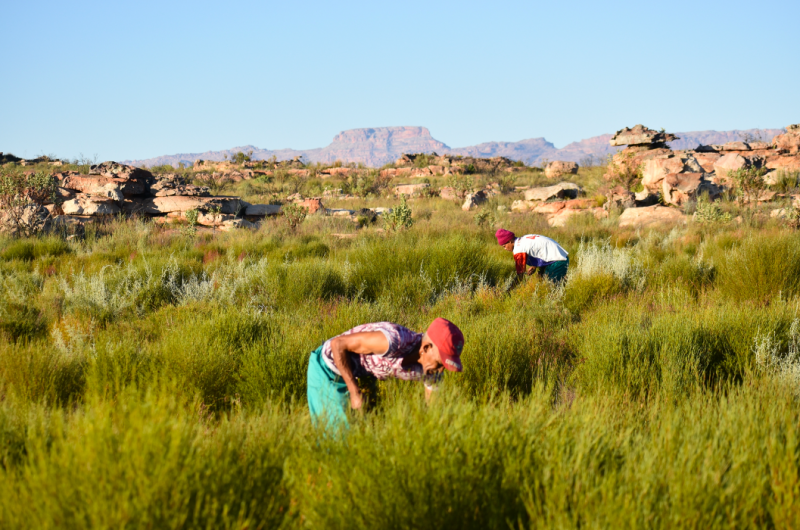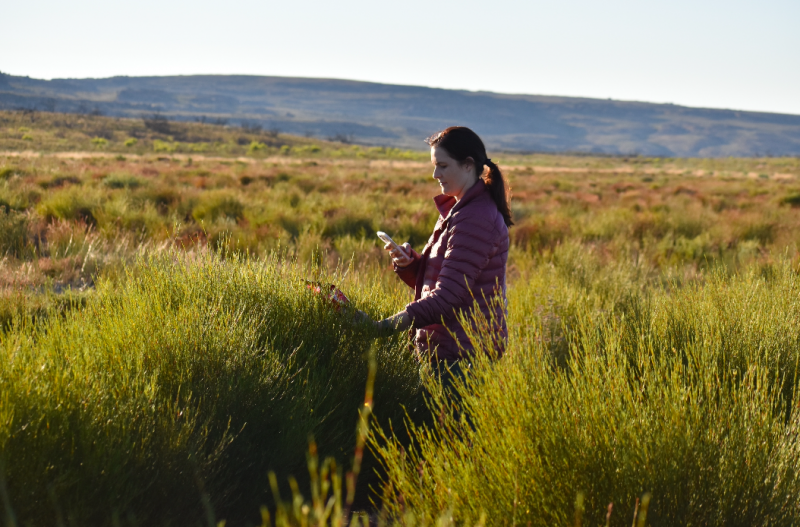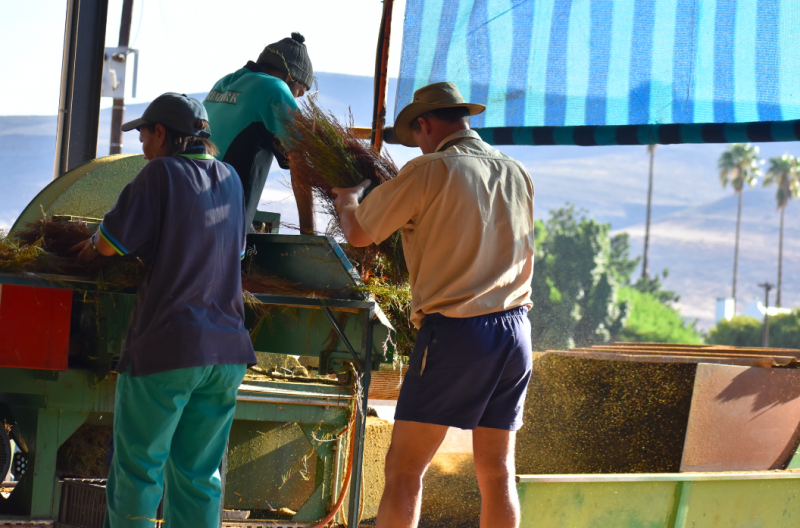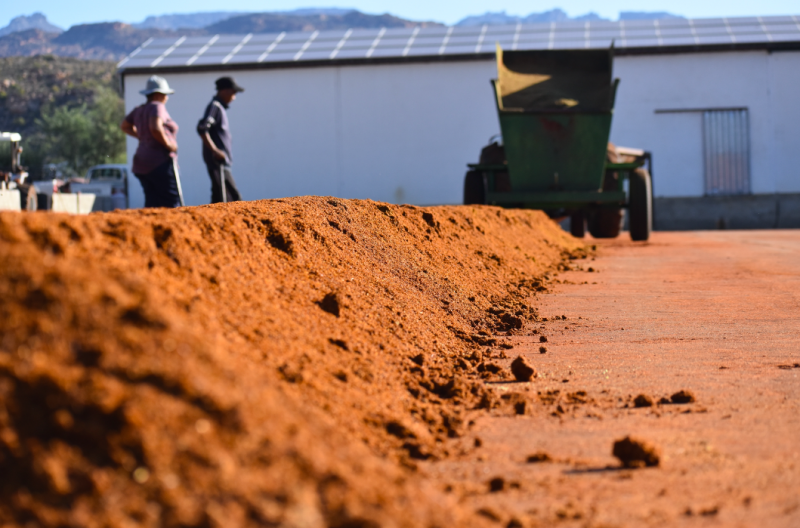A little over a year ago we had the great pleasure of being able to visit the Biedouw Valley high up in the Cederberg with Pete Ethelston and Kirsty Reid of Red Espresso. And what an incredible experience it was! The Red Espresso team go at least once a year to spend time with their amazing partner farmers and it was wonderful to see how this much beloved product comes to life!
Words by Iain Evans
It may surprise you to learn, as it did I, that rooibos is not actually a tea at all. Aspalathus linearis as it is known by botanists, is actually a species of fynbos. Infusions of fruit, leaves, roots and other plant parts are referred to as tisanes (herbal teas) to prevent confusion with "tea" made from the tea plant. I learned this fact after nearly 40 years of drinking rooibos, and living in the only country in the world where rooibos is geographically endemic, as we ascended the district road that leads out of the Clanwilliam Valley and into Cederberg mountains, a biome that has naturally produced rooibos since time began.

Pete pulls the 4x4 over to the side of the dirt road at the top of the pass, and we look into the valley (pictured above). The only sounds are the crunch of our shoes on the gravel and the wind in our ears. We can see the farmhouse, a block of white buildings, specks in the deep afternoon shadows cast by the surrounding hills. Overhead a raptor thermals silently above us. The landscape is breathtakingly beautiful. Deep valleys carved between the rugged peaks and ledges of the Cape Fold Mountains, stained red by the stark sunlight and bathed in a purple hue as the sun sets, as it has, day after day, for millennia. Time seems to stand still out here. We are about to discover what rooibos really is, and meet the people who farm it.
This farm belongs to Sarel and Leonie Van der Merwe. Pete has told us so much about them in the 3 hour drive from Paarl to Clanwilliam, that I feel nervous on arrival at Biedouw Valley Farm. Sarel is still out in the fields at work when we arrive. Leonie runs the many facets of the farm , the respected Matriarch of the Valley, and she’s not done for the day yet.
“I have been coming here for 18 years” Pete tells us. “See these trees?” He points to a number of fever and waterberry trees around the farmhouse, “ They were planted as a gift from us when we first came here.” We pull up to the farm house and park under one of the very trees that were gifted to the family, now a towering oasis of shade against the bright midday sun. “Oubaas,” as Sarel is affectionately known, “is one of the best guys I’ve ever met.” says Pete.
Pete and Monique Ethelston, co-founders of Red Espresso have been working with Sarel since 2005 when they started the business. They have since become close family friends and steadfast business partners. This shared history is evident as we look at the photographs in the farm office – a black and white team photo of the 1972 Clanwilliam Rugby team, hangs below an original photo of Ox wagons making the Trek North, and on the opposite wall a photo of a very young Pete and Monique Ethelston and the Red Espresso Team from those early days.
Leonie is not quite finished with work for the day, for our official welcome of chats with evening tea, so we wander up to the large concrete tea courts, while Pete explains the process of fermenting the tea before bagging it, a process we are promised we will see the following day. Meanwhile Bertu, eldest son of Sarel, wanders over from the shed to greet Pete and the English visitors from Durban.
“The water pipe broke, so we spent most of the morning fixing it, and now the rye grass is late for planting” he tells us. I notice his hands. They are farmers hands. His fingers are thick and calloused. Grazes cover his knuckles and each wrinkle in the skin of his fingers is dark with dirt. I look sheepishly down at my own soft, white hands and stuff them out of sight into my hoodie pockets. “Ma is packing orders and Oubaas will come down from the mountain now.” he tells us.
We wander back down to the farm office. There is a healthy herd of cattle in the veld beyond, and a decent herd of sheep jostle past, taking up the whole road. Adjacent the storehouses are several horses. Bertu is an accomplished, competitive horseman we hear. He raised one, an orphan, from birth. “Hy is baie hans” Bertu tells us. We can’t find an English word for “hans” but eventually work it out to be “raised by hand and therefore needy” – basically, the horse thinks Bertu is its mother and father in one, and acts more like a dog than a horse. He has been in several of the local newspapers, taking the horse into the pub, and having it stand in his living room, such is the bond between Bertu and this special animal.

On our return, Leonie bustles out of the office and there is much banter, hugging and news swapped – the broken pipe, a domestic squabble with one of the labourers, the late planting of the rye grass and the latest Wordle score of the day (English and Afrikaans) – we are soon up to speed with the most important news of the farm, the family and the neighbours. And, of course, the plan – always a plan – what needs to happen and when, the timetable of a busy farmer’s wife and her sons. We soon meet Charl – the youngest son, tall, lanky and friendly. His dogs close at his heels. “The workers go up the mountain at 6am. We will take them. You can drive up and meet them there.” Charl tells us. Though it is late in the season, Oubaas has instructed his sons and his workers to leave a section of rooibos for us, so we can see the full bushes growing and see how it is harvested.
The following morning dawns cold and bright. The tears stream down our faces as the cold air bites into our exposed skin standing on the back of the bakkie, winding up and out of the valley on the stony gravel road. We couldn’t be happier. We climb, higher and higher, around the many hairpin bends and switchbacks. We pass only one other vehicle; just your average school drop off over the mountain, you know, a good 35 minutes drive, down across the valley, up the other side and into town. We finally reach the top – an expansive plateau, as if the top of the mountains have been scraped flat with a giant trowel. Only strange sandstone outcrops creating abstract sculptures disrupt the view across the top. You can see forever up here. There are remnants of stone walls built to keep in sheep. Oubaas used to keep sheep up here, but the leopards killed too many of them. Only one leopard has ever actually been spotted, but they’re out here for sure. Now the sheep stay down at the farmhouse. We drive across the plateau on perfectly maintained farm roads, with only baboons and crows as company. The sun is making its way up, yet the air is still very cold. We finally round a corner and see the rows of rooibos, planted in long, neat lines.

The rows are raised in a deliberate fashion, and each bush is evenly spaced from the next. I feel the same excitement I felt when seeing my first coffee farm – the same exhilaration - that moment where trivia becomes knowledge – a first hand experience of the actual plant, alive and thriving, its bounty waiting to be harvested and turned into the product we know and love – yet out here – so very far away from a café or an espresso machine – it sets a tingling through my body. In the lyrics of The Killers, like “magic soaking my spine.”
I’m sure Pete is lost. He assures me he is not. “Oubaas said we go around the waterhole, up the bank, around the corner, past the old crop and we’ll see the guys on the left. They are hand cutting another section this morning, but he said they know The Plan and will jump on with us and go to cut the section he’s left for us!” Ah. The Plan. How could we doubt!

Sure enough, we soon see the men, heads down, sickles glinting in the morning light. They stop when they see us and we hear a few shouts across the rows. They soon gather their equipment and clamber up onto the bakkie. There are 12 of them. They are wiry and strong, with weathered lines on their faces as wide as their grins.
The foreman knows Pete well. He tells us he’s been working for Oubaas for 12 years. Most of the guys are his friends or relations, and they mostly come from Wupperthal and then stay during the harvest season to help with the harvest and the farm work. We learn that the men are incentivised by how much they cut. Like coffee, once harvested, the crop needs to be processed within 24 hours. They only have a few hours to cut, and they stack their bundles of rooibos at the end of each row, where the bakkie will come around later to collect both them and their bounty, drive it back down the mountain to the tea courts where it will be weighed, cut and processed on the tea courts the following morning. The guys move quickly, jostling for position in their sections, and moving with skilled, precise movements, razor sharp sickles slicing through bush after bush, adding to the bundle, stuffed between the cutters thighs before being bagged and stacked. Time is money. And money for this community is seasonal.

I am surprised by how big the bushes are. They stand about chest high - think and wide. The stems are, as the name would suggest, deep red and the spindly, rosemary-looking leaves are a dark green and the plant has the most beautiful little yellow flowers. These are 4-5 year old bushes, the oldest a plant can get before it dies. The very high altitude and therefore cold temperature and much tougher growing conditions for the rooibos bushes yields an intense flavour that can’t be found elsewhere. Perfect for Red Espresso then! Most commercially farmed rooibos is found in Clanwilliam at lower altitude. “We searched for only the best rooibos – that which is grown at highest altitude as close to nature as possible – this is the rare quality that sets Red Espresso apart. Most people would not ascend the district road out of Clanwilliam for Rooibos but we did!”


We take lots of photos and walk up and down the rows. I look into the faces of Pete and Kirsty. Pete is deep in thought. It must be an almost sacred experience for him, standing in the heart of the rooibos rows, breathing in the sweet scent, in the cold morning air, an unlikely crop that has become a legacy for his family. Kirsty, on the other hand is also taking it in. Standing with a box of Red Espresso, the finished product, and snapping Instagram reels amongst the living, thriving, plants. We observe the men cutting and bundling their rooibos for half an hour or so. It is back-breaking work and although they make it look easy, Pete warns us, “The stalks are tough, technique is really important to getting through them successfully.” We drop the team back at their original section, where they hastily make a small fire to brew some tea.
“There is a freshwater spring and a cave over there. We can show you the paintings, the foreman will show us the way,” Pete says, “Let’s have our morning coffee there!” The cave is one of many thousands scattered across the plateaus of the Cederberg mountains. The San, the hunter-gatherers of the bush, used them as shelter as they traversed the escarpments of the Cape Fold mountains. The paintings reveal some surprising facts – there are elephants depicted on the walls. There are ships. There is an uncanny painting of a voortrekker lady in billowing skirts and a bonnet, giant-like next to the tiny San people. And many, many handprints, like a class register on the wall. The San thrived up here many thousands of years ago – they had fresh spring water, caves for shelter, elephant and game to hunt, and a view for many hundreds of kilometres – seeing danger from afar and moving off. And we know they went as far as the ocean, judging by the ships painted on their cave wall. It is a surreal moment. I think about the labourers. I think about the voortrekkers. I think about the elephants – now extinct in this region. Almost like the San. Too similar.
We talk about rooibos and the development of a seemingly simple idea of using this crop in an espresso machine environment and discover that it is not simple at all. Along with the patented grind, there is also well-researched and implemented science to the final Red Espresso product that begins with where and how it is grown and touches each point of the journey from crop to cup. We talk about business. We have many cups of coffee and many long, fascinating discussions. The discussions carry on, on the back of the bakkie, over morning tea, over lunch and around the braai that afternoon. We are early for the braai. Sarel, Leonie, Charl and Bertu and some relatives are finishing work early to come to the braai. It is going to be a celebration! As an English South African I am excited, and a little nervous about a family braai deep in the heartland of a 3rd generation Afrikaans farming community, wanting to be respectful of the family traditions. Beers are opened, wine is poured. Snacks are served. Leonie is in the hearty farm kitchen kneading the fresh bread rolls (glazed with rooibos!). We sit around the braai and talk, chew fatty biltong and settle into the dusk. Charl is braaimaster. He is cooking several types of protein, I wonder who is going to eat it all.
I sit between Pete and Sarel. It’s the first time I’ve really had a chance to speak directly with Oom Sarel and I’m dying to ask him the million questions I have – about farming, about his family, about rooibos, about life. Pete spurs him on, prompting him to tell me subtle details that he might not really think I need to know. In half Afrikaans and half English. They have a knack for finishing each others’ stories, and I start to grasp the depth of their bond. I learn a huge amount about Oubaas in those few hours around the braai. I learn about his rocky start to farming in this valley – that he feels he wouldn’t have made it if it hadn’t been for the generosity of a neighbour, lending him an old tractor to clear the land. Something he will never forget or take for granted. I learn that that he went to Cape Town to buy a lorry, saw a dumper, broom and a bucket and fashioned the first rudimentary rooibos spreader, an invention now widely used in the industry. I learn that he is planning to erect an Archimedes screw up on the mountainside to generate his own power. I learn that he supports a small group of seed merchants from Calvinia, who every year, come and camp on the farm, collect seed and then sell it back to Sarel and his neighbours, making their entire annual income from this venture. Leonie tells us about the Riel dancers (Rieldans is an ancient celebratory dance performed by the San) and that they donate a percentage of income from the farm to keep this important local cultural tradition alive. I learn that the communities around the Biedouw Valley are as much a part of their lives as anything else. It is clear that the drive to do business sustainably and with community at heart is an important part of this relationship. With Pete's Seeds of Hope subsistence farming project that he started. Red Espresso has really made a difference in the lives of the Heuningvlei subsistence farmers and they work with more than 20 farmers now. Seeds of Hope was launched in 2014 and the first farmer that worked with them has now bought himself a bakkie (they still use donkey carts where they live and farm) and he can now help the other farmers transport their tea to Sarel's tea courts where the tea is cut and dried on the tea courts. Pete then pays them above market price for their tea.
I learn how difficult it was for Sarel and Leonie as independent operators, to sustain their farm with price fluctuations in excess of 300% from droughts to seasons of abundant rainfall. How Pete and the Van der Merwe’s navigated a fixed price – as a single supplier of Red Espresso’s rooibos, with a commitment to each others’ livelihoods – that no matter what, the quality would remain extremely high and the price paid would be consistently higher than the market price, despite the highs and lows – something that must have tested their loyalty and their friendship to the extreme.
We’re called in for dinner, squinting as we enter the kitchen, bright and warm, with the most delicious smells coming from the oven. We sit around the long harvest table in the middle of the kitchen – we hold hands and say a small prayer of thanks before tucking into the most sumptuous feast. Besides the fresh rolls, there is curried noodle salad, beans, and meat. Meat for days. We talk, we laugh, there is lots of gentle ribbing of each other – my nervousness has gone – I find myself listening, thinking and speaking in Afrikaans, to my great surprise. We conclude dinner by listening to an Old Clanwilliam local, and Afrikaans comedian, Toller van der Merwe’s joke on youtube about a merry-go-round. It has everyone in stitches, though I’m pretty sure I missed most of the subtle humour. Sarel has moved to his favourite chair, Pete next to him. The evening concludes with us making the family after dinner coffees using a moka pot, a Minipresso and an AeroPress – much to their amusement. There are many questions about the different coffees and the different methods on offer before we disperse for the night. The farmers will be up at dawn, with much to do, such is farm life.
The following morning, we get to watch the second half of the rooibos journey. The bundles that we watched the men cut yesterday have been stacked next to the cutting machine. The leaves have already started to turn from green to red. Bertu is operating the cutter with his team, while Charl is neutering a herd of young bull calves in the adjacent yard.

Once the rooibos is cut, stalks, leaves and all, it is fed into a trailer, this trailer is pulled along the tea court laying out a long thick stripe of rooibos in a heap.

This is then “spread” using an attachment onto the back of the tractor, the spreader invention in action!

This will cover the courts for the day, dried out by the sun. It smells extremely sweet, like you’ve inhaled deeply from the rooibos tin, except it is more humid, almost sticky in your nose, in fact, it is hot to the touch! As we are invited to put our hands into the mound, the heat and moisture from the fermenting rooibos turns to steam in the cool morning air, making a beautiful sight as it is backlit by the morning sun, and the tea court is framed by the ancient gum trees around the yard.
I have wanted to get a good photo of Oom Sarel. A decent portrait. But asking him to pose is out of the question. Not a chance! I ask Pete to take him down to the end of the tea-courts and then loop back towards me so I can nail the shot. I put on the long lens and lie, like a sniper in the grass, getting a good perspective, light behind me and a chance to shoot Sarel in his natural environment. They turn, he stops, mid-conversation and I see him grin under his trademark floppy farm hat and shake his finger at Pete, who later tells me he said – “Ek sien nou ’n slang in die gras,” as he laughs at my poor attempt to hide from him!

We leave the farm at lunch time. Our goodbyes are joyful and sincere. There are hugs and firm handshakes. Promises of a return visit and there are lots of presents given and received. Oubaas has gone off to plant the ryegrass, Leonie has business in Clanwilliam to attend to, Charl is busy with the calves and Bertu has gone off to fix the water pipe again.
As we wind our way out of the valley it seems like time really has stood still. I feel the spirit of the San people and the local subsistence farmers. I can sense the emotions that Pete and Kirsty feel leaving this special place, and I’m certain that Monique and Nic, and the rest of the Red Espresso family feel the same each and every time they enter the beautiful Biedouw Valley and smell the sweet fermenting smell of this miracle plant known as, rooibos.